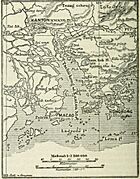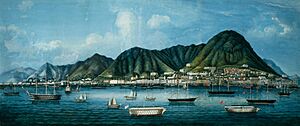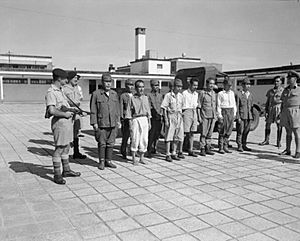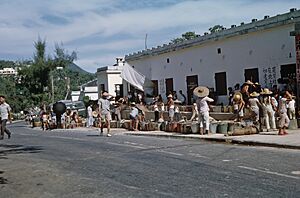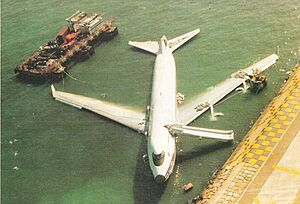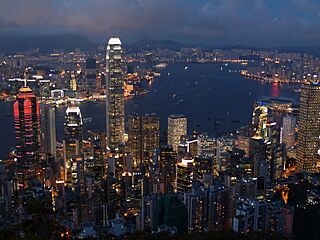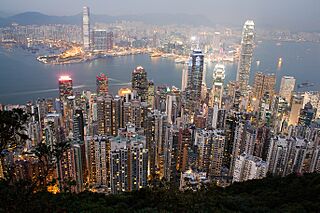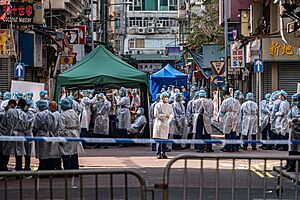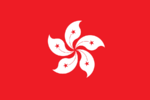History of Hong Kong facts for kids
The region of Hong Kong has been home to people since the Old Stone Age. It later became part of the Chinese Empire, joining the Qin dynasty (221–206 BC). Hong Kong started as a small farming and fishing village that also produced salt. Over time, it grew into an important free port and then a major international financial center.
The Qing dynasty gave Hong Kong to the British Empire in 1842 after the First Opium War. This was agreed in the Treaty of Nanjing. Hong Kong then became a British crown colony. Britain also won the Second Opium War, which led the Qing Empire to give up Kowloon in 1860. Later, Britain leased the New Territories for 99 years starting in 1898.
Japan took control of Hong Kong from 1941 to 1945 during World War II. After the war ended in 1945, British and Chinese troops together freed Hong Kong, and it returned to British rule. Hong Kong's population grew a lot because many refugees came from Mainland China, especially during the Korean War and the Great Leap Forward. In the 1950s, Hong Kong changed from a place for trading goods to a place known for its factories and manufacturing. When China started its Chinese economic reform, many factories moved there. This helped Hong Kong develop its business and financial industries even more.
In 1984, British Prime Minister Margaret Thatcher signed the Sino-British Joint Declaration. This agreement caused many people to leave Hong Kong. On 1 July 1997, Hong Kong was returned to Chinese rule in what is known as the Handover of Hong Kong. Hong Kong then adopted its own special set of rules called the Hong Kong Basic Law.
In the 21st century, Hong Kong has continued to be a successful financial hub. However, there have been ongoing issues with public protests, unhappiness with the government, and concerns about China's influence. A plan to put Hong Kong Basic Law Article 23 into action caused a lot of debate and a huge protest on 1 July 2003. This led to the plan being put aside. People also showed their unhappiness with the election system, which led to the 2014 Hong Kong protests. In 2019, a proposed extradition bill was seen as another step by the Chinese Communist Party to weaken Hong Kong's legal system. This started a new wave of protests. In 2020, China's National People's Congress passed the Hong Kong national security law to bring back order. This new law was strongly criticized by those who support democracy and made many people in the city feel worried about their future.
Contents
Early History of Hong Kong
Archaeological finds show that people lived in Hong Kong over 30,000 years ago. Stone tools from the Old Stone Age have been found in Sai Kung at Wong Tei Tung. These tools might have come from a place where stone tools were made during the Late Neolithic Period or Early Bronze Age.
More evidence of early settlements was found at Wong Tei Tung in Sham Chung, near Three Fathoms Cove in Sai Kung Peninsula. About 6,000 artifacts were discovered there.
The Neolithic Era began around 7,000 years ago in Hong Kong. The people living here at that time were the Che people, who also lived along the coast of Southern China. Most ancient sites from this period are found on the western shores of Hong Kong. This area was likely chosen to avoid strong winds and to easily gather food from the sea. Settlements have been found on Cheung Chau, Lantau Island, and Lamma Island.
During the Warring States period, many Yuet people moved into the area from the north. They probably came to escape the troubles in the northern regions. Tools made of Bronze for fishing, fighting, and rituals have been found on Lantau Island and Lamma Island. Ma Wan is the earliest known settlement in Hong Kong with direct evidence of people living there. The Yuet people mixed with and became part of the local Che people. Hong Kong's early history period ended around the time of the Qin and Han dynasties, when the area became part of Panyu County.
Hong Kong Under Imperial China (221 BC – 1841 AD)
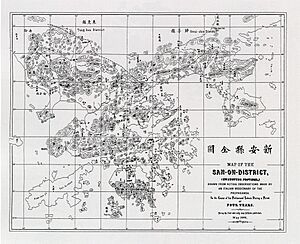
The land that is now Hong Kong was loosely connected to China during the Qin dynasty (221–206 BC). It was also part of the ancient kingdom of Nam Viet (203–111 BC). During the Qin dynasty, the area was managed by Panyu County until the Jin dynasty.
Archaeological finds show that the population grew during the Han dynasty (206 BC – AD 220). In the 1950s, a tomb at Lei Cheng Uk from the Eastern Han dynasty (25–220 AD) was found. Experts believe that salt production might have been common in Hong Kong about 2,000 years ago, but there's no final proof yet. Tai Po Hoi, the sea near Tai Po, was a major place for pearl hunting in China from the Han dynasty to the Ming dynasty (1368–1644), with the most activity during the Southern Han (917–971).
From the Jin dynasty to the early Tang dynasty, Hong Kong was governed by Bao'an County. Under the Tang dynasty, the Guangdong region became a busy international trading center. The Tuen Mun area, now in Hong Kong's New Territories, was a port, a naval base, a salt production site, and later a place for finding pearls. Lantau Island also produced salt, and there were even riots by salt smugglers against the government. From the middle of the Tang dynasty until the Ming dynasty, Hong Kong was governed by Dongguan County.
On 10 May 1278, Child Zhao Bing, the last emperor of the Song Dynasty, was crowned at Mui Wo on Lantau Island. This event is remembered by the Sung Wong Toi memorial in Kowloon.
During the time of the Mongols, Hong Kong saw its first big population increase as Chinese refugees came to the area. Most of these refugees were loyal to the Song dynasty and were running away from the Mongol conquest of Song China.
Even with new people and some farming, the area was mostly hilly and not very fertile. People had to rely on trading salt, pearls, and fish to make money. Some families built walled villages to protect themselves from bandits, other families, and wild animals. The Chinese pirate Cheung Po Tsai from the Qing dynasty became a famous legend in Hong Kong.
In the mid-17th century, after a policy called the Great Clearance removed most of the people from the region, many Hakka people moved from inland China to Xin'an County, which included modern Hong Kong.
During the Ming and Qing dynasty, Hong Kong remained under the control of Xin'an County (which was renamed from Bao'an County). Later, it was taken over by the British. As a military outpost and trading port, Hong Kong became known around the world.
Before the British government took over the New Territories and New Kowloon in 1898, Punti, Hakka, Tanka, and Hoklo people had lived in Hong Kong for many years. They are considered the original inhabitants of Hong Kong. The Punti and Hoklo lived in the New Territories, while the Tanka and Hakka lived in both the New Territories and Hong Kong Island. British reports said that the Tanka and Hoklo people had lived in Hong Kong "since time unknown." The Encyclopaedia Americana even said that Hoklo and Tanka people lived in Hong Kong "since prehistoric times."
When the Union Flag was raised at Possession Point on 26 January 1841, Hong Kong Island had about 7,450 people. Most were Tanka fishermen and Hakka charcoal burners living in small villages along the coast. In the 1850s, many Chinese people moved from China to Hong Kong because of the Taiping Rebellion. Other events like floods, typhoons, and famines in mainland China also made Hong Kong a place where people could escape trouble.
Colonial Hong Kong (1841 – 1930s)
| Date | Agreement | What Happened | Notes |
|---|---|---|---|
| 20 January 1841 | Convention of Chuenpi | Britain was given Hong Kong Island | This included Green Island and Ap Lei Chau. Before this, the area was part of Xin'an County. |
| 29 August 1842 | Treaty of Nanking | Hong Kong Island was officially given to the United Kingdom and became a British colony. | |
| 18 October 1860 | Convention of Beijing | Britain was given Kowloon | This was the area south of Boundary Street, including Ngong Shuen Chau. Before this, Kowloon Peninsula was part of Xin'an County. |
| 1 July 1898 | Second Convention of Beijing (Convention for the Extension of Hong Kong Territory) |
Britain leased the New Territories | This included the area south of the Shenzhen River in Xin'an County, along with New Kowloon, Lantau, and other islands. |
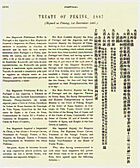
By the early 1800s, the British Empire relied heavily on importing tea, silk, and porcelain from China. While Britain sold luxury items like clocks to China, there was a huge trade imbalance. China wanted a lot of silver, which was hard for the British to get in large amounts. To balance trade, Britain started exporting opium grown in India to China. By the late 1800s, China grew most of the opium it used. A Chinese official named Lin Zexu told Queen Victoria that the Qing government was against the opium trade. This led to the First Opium War, which lasted from 1839 to 1842. Britain took over Hong Kong Island on 25 January 1841 and used it as a military base. China lost the war and had to give Hong Kong to Britain in the Treaty of Nanking, signed on 29 August 1842. The island then became a Crown Colony of the British Empire.
Christian missionaries started many schools and churches in Hong Kong. St Stephen's Anglican Church in West Point was founded by the Church Mission Society in 1865. Ying Wa Girls' School in Mid-levels was started by the London Missionary Society in 1900. The Hong Kong College of Medicine for Chinese was also founded by the London Missionary Society in 1887. Sun Yat-sen was one of its first two graduates in 1892. This college later became the School of Medicine at the University of Hong Kong, which was established in 1911.
Sun Yat-sen, along with fellow students Yeung Hok-ling, Chan Siu-bak, and Yau Lit, began to talk about overthrowing the Qing empire while he was studying medicine. The Qing government called these four students the Four Bandits. Sun attended To Tsai Church (道濟會堂), which was founded by the London Missionary Society in 1888. Sun led the Chinese Revolution of 1911, which changed China from an empire into a republic.
In April 1899, the people of Kam Tin rebelled against the British colonial government. They defended themselves in Kat Hing Wai, a walled village. After several failed attacks by British troops, the iron gate of the village was blown open. The gate was then sent to London for display. However, the Tang Clan demanded its return in 1924, and the gate was finally brought back in 1925 by the 16th governor, Sir Reginald Stubbs.
The first gas company opened in 1862. In 1890, the first electric company started. For getting around locally, rickshaws were replaced by buses, ferries, and trams. Imperial Airways set up a base in 1936. Every industry saw big changes and growth. Western-style education improved thanks to the efforts of Frederick Stewart. This was an important step in separating Hong Kong from mainland China during the political chaos of the falling Qing dynasty. The foundation for Hong Kong's future as a financial center was laid when The Hongkong and Shanghai Bank opened in 1865.
The Third Pandemic of Bubonic Plague hit Hong Kong in 1894 Hong Kong plague. This led to rules about where different races could live, especially with the creation of the Peak Reservation Ordinance. It also showed the importance of the first hospital.
When World War I started in 1914, fears of an attack on the colony caused 60,000 Chinese people to leave. However, Hong Kong during World War I saw no direct fighting. Hong Kong's population continued to grow in the following decades, from 530,000 in 1916 to 725,000 in 1925. Still, the problems in mainland China in the 1920s and 1930s made Hong Kong vulnerable to an invasion from Imperial Japan.
In 1937, Hong Kong was hit by a major typhoon.
British Lease of Kowloon and the New Territories
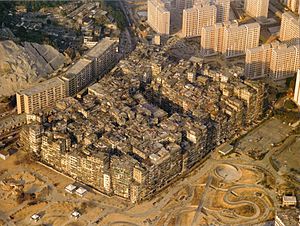
In 1860, after the Second Opium War, the UK gained permanent control over the Kowloon Peninsula. This is the mainland Chinese area just across the water from Hong Kong Island. This agreement was part of the Convention of Beijing, which ended that conflict.
In the second half of the 1800s, the British became more and more concerned about the Chinese-controlled islands around their new port. After the Second Opium War (1898, Convention for the Extension of Hong Kong Territory), the British negotiated a lease for the "New Territories." In this agreement, the British would get newer outlying islands for 99 years.
On 19 December 1984, British Prime Minister Margaret Thatcher and Chinese Premier Zhao Ziyang signed the Sino-British Joint Declaration. In this agreement, Britain agreed to return not only the New Territories but also Kowloon and Hong Kong itself when the lease ended. China promised to use a "One Country, Two Systems" plan. This meant that for fifty years, people in Hong Kong could continue to have capitalism and political freedoms that were not allowed on the mainland.
On 1 July 1997, the lease ended, and the United Kingdom handed over control of Hong Kong and its surrounding areas to the People's Republic of China.
Japanese Occupation (1940s)
Hong Kong was taken over by Japan from 23 December 1941 to 15 August 1945. This period, known as '3 years and 8 months,' stopped the economy. British, Canadian, Indian, and Hong Kong Volunteer Defence Forces fought against the Japanese invasion, led by Sakai Takashi. The attack began on 8 December 1941, just eight hours after the attack on Pearl Harbor. Japan quickly gained control of the air on the first day of battle, and the defending forces were outnumbered. The British and Indians pulled back from the Gin Drinker's Line and then from Kowloon under heavy bombing and artillery fire. Fierce fighting continued on Hong Kong Island; the only reservoir was lost. Canadian Winnipeg Grenadiers fought bravely at the important Wong Nai Chong Gap, which was the path between the north and the quiet southern parts of the island.
On 25 December 1941, a day locals call Black Christmas, British colonial officials, led by the Governor of Hong Kong, Mark Aitchison Young, surrendered in person at the Japanese headquarters on the third floor of the Peninsula Hotel. Isogai Rensuke became the first Japanese governor of Hong Kong.
During the Japanese occupation, prices went way up (hyper-inflation), and food was rationed, which became normal daily life. It became illegal to have Hong Kong Dollars, which were replaced by the Japanese Military Yen. This new money had no real value and was issued by the Imperial Japanese Army administration. During the three and a half years of Japanese occupation, many Hong Kong civilians lost their lives. Philip Snow, a famous historian of that time, said that the Japanese cut food for civilians to save it for soldiers, often to starvation levels. They also sent many people to areas on the mainland where there was famine and disease. Most of these people had only come to Hong Kong a few years earlier to escape the violence of the Second Sino-Japanese War in mainland China.
By the end of the war in 1945, Hong Kong was freed by British and Chinese troops working together. The population of Hong Kong had dropped to 600,000, which was less than half of the 1.6 million people before the war. This was due to a lack of food and people moving away. The communist revolution in China in 1949 led to another big increase in Hong Kong's population. Thousands of refugees moved from mainland China to Hong Kong, making it an important entrepôt (a place where goods are stored and shipped). This continued until the United Nations ordered a trade embargo (a ban on trade) on mainland China because of the Korean War. More refugees came during the Great Leap Forward.
After the Japanese Occupation
After World War II, many countries around the world became independent from colonial rule. However, Britain decided to keep Hong Kong for important strategic reasons. To strengthen its control, new constitutional changes, called the Young Plan, were suggested. These changes were meant to respond to the trend of decolonization and meet the needs of the people. However, the political system changed very little because of the unstable situation in Mainland China at that time, which caused many mainland residents to move to Hong Kong.
Modern Hong Kong
Modern Hong Kong Under British Rule (1950s–1997)
The 1950s
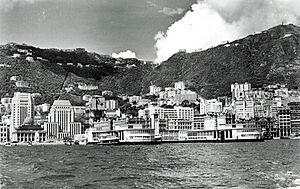
The skills and money brought by refugees from Mainland China, especially from Shanghai, along with many cheap workers, helped the economy recover. At the same time, many foreign companies moved their offices from Shanghai to Hong Kong. Hong Kong experienced amazing growth, changing from a trading hub to a place of industry and manufacturing. Early factories, where many workers spent most of their days, made almost anything that could be produced in a small space. This included buttons, artificial flowers, umbrellas, textile, enamelware, footwear, and plastics.
Large squatter camps (informal settlements) grew across the area, providing homes for the huge and growing number of immigrants. However, these camps were dangerous because of fires and health risks, leading to disasters like the Shek Kip Mei Fire. Governor Alexander Grantham responded with a plan for "multi-storey buildings" as a new standard. This was the start of Hong Kong's high-rise buildings. Conditions in public housing were very basic, with several families sharing cooking areas. Other parts of life changed too, as traditional Cantonese opera gave way to big screen cinemas. The tourism industry began to become more organized. North Point became known as "Little Shanghai" (小上海), as many people saw it as the new Shanghai after it was given up by China.
The 1960s
The manufacturing industry started a new decade, employing many people. This period is seen as a turning point for Hong Kong's economy. The construction business also got new life with detailed rules for the first time since World War II. While Hong Kong started with a low GDP, it used the textile industry as a base to boost its economy. China's cultural revolution brought Hong Kong into a new political situation. Events like the 1967 riot filled the streets with homemade bombs and chaos. Police and the British military had to defuse as many as 8,000 homemade bombs. About one in every eight bombs was real.
Family values and Chinese traditions were challenged as people spent more time in factories than at home. Other issues during this time included water shortages, long working hours, and very low wages. The Hong Kong Flu of 1968 infected 15% of the population. Despite all these challenges, "Made in Hong Kong" changed from being a label for cheap, low-quality products to one for high-quality goods.
The 1970s
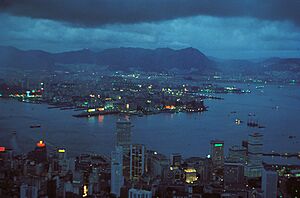
The 1970s saw the government extend subsidized education from six years to nine years. Hong Kong also set up its country parks system.
The opening of mainland China's market and rising salaries caused many manufacturers to move north. Hong Kong strengthened its role as a business and tourism center in Asia. High life expectancy, literacy, income per person, and other social and economic measures show Hong Kong's success over the last four decades of the 20th century. Higher incomes also led to the building of the first tall, private housing estates like Taikoo Shing. From this time on, people's homes became a part of Hong Kong's famous skyline.
In 1974, Murray McLehose created the ICAC, the Independent Commission Against Corruption. Its goal was to fight corruption within the police force. Corruption was so widespread that many police officers protested against being prosecuted. Despite early opposition from the police, Hong Kong succeeded in its fight against corruption, eventually becoming one of the least corrupt societies in the world.
The early 1970s also saw new laws requiring equal pay and benefits for men and women doing the same work. This included the right for married women to be permanent employees.
The 1980s

In 1982, British Prime Minister Margaret Thatcher hoped that China's government would become more open and that economic reforms on the mainland would allow British rule to continue. The meeting that followed led to the signing of the Sino-British Joint Declaration and the idea of "One country, two systems" proposed by Deng Xiaoping. By this time, Hong Kong was known as one of the wealthiest places in the Far East. Political news was everywhere in the media. While real estate saw a big increase, the financial world was shaken by panics, leading to many policy changes and "Black Saturday." Warnings about the upcoming handover caused emigration to reach record highs. Many people left Hong Kong for the United States, Canada, the United Kingdom, Australia, Japan, and other places around the world that had no communist influence.
Hong Kong's movies became very popular internationally. Some of the biggest stars included Jackie Chan and Chow Yun-fat. The music world also saw new cantopop stars like Anita Mui and Leslie Cheung.
The 1990s Until 1997
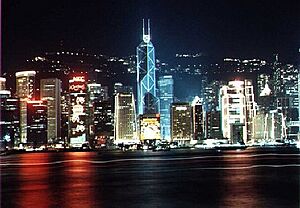
On 4 April 1990, the Hong Kong Basic Law was officially accepted as the mini-constitution for the Hong Kong SAR after the handover. Those who supported Beijing welcomed the Basic Law, calling it the most democratic legal system ever in China. Those who supported democracy criticized it for not being democratic enough. In July 1992, Chris Patten was appointed as the last British Governor of Hong Kong. Patten had been the Chairman of the Conservative Party in the UK until he lost his seat in the general election earlier that year. Relations with the Chinese government in Beijing became more difficult as Patten introduced democratic reforms that increased the number of elected members in the Legislative Council. The Chinese government saw this as breaking the Basic Law. On 1 July 1997, the United Kingdom handed Hong Kong over to Communist China. The old Legislative Council, elected under Chris Patten's reforms, was replaced by a Provisional Legislative Council. Its members were chosen by a selection committee appointed by the Chinese government. Tung Chee Hwa became the first Chief Executive of Hong Kong, chosen in December by a selection committee whose members were appointed by the Chinese government. He immediately kept all the existing policy secretaries, ensuring things continued smoothly.
| Things That Stayed the Same After 1997 | Things That Changed After 1997 |
|---|---|
|
|
Hong Kong as a Chinese Special Administrative Region (1997–Present)
The new millennium brought a series of important events. A large number of people who had been against the handover found themselves adjusting to the new situation. Hong Kong Basic Law Article 23 became a big issue, leading to protests in different parts of Hong Kong with as many as 750,000 people (out of about 6,800,000 at the time). The government also had to deal with the SARS outbreak in 2003. Another health crisis, the Bird Flu Pandemic (H5N1), grew from the late 1990s, leading to the killing of millions of chickens and other poultry. This event brought Hong Kong into global attention. At the same time, the economy tried to adjust financially. Soon, the political situation became tense, and the Chief Executive's position was challenged in terms of culture, politics, and management.
Hong Kong's skyline has continued to change, with three new skyscrapers becoming very prominent in Kowloon, Tsuen Wan, and Victoria, Hong Kong. The 415-meter (1,362-feet) tall, 88-story Two International Finance Centre, finished in 2003, was once Hong Kong's tallest building. It has since been surpassed by the 484-meter (1,588-feet) tall, 118-story International Commerce Centre in West Kowloon, which was completed in 2010 and remains the tallest skyscraper in Hong Kong. Also notable is the 320-meter (1,051-feet) tall Nina Tower in Tsuen Wan. Eight more skyscrapers over 250 meters (825 feet) have also been built during this time.
Occupy Central with Love and Peace (OCLP) was a civil disobedience campaign in Hong Kong. It was started by Reverend Chu Yiu-ming, Dr. Benny Tai Yiu-ting, and Chan Kin-man on 27 March 2013. Its goal was to pressure the Chinese government to change the election systems for the Hong Kong Chief Executive and Legislative Council. They wanted these systems to meet "international standards for universal suffrage," as promised in the 1984 Sino-British Joint Declaration and Article 45 of the 1997 Hong Kong Basic Law. The campaign's plan was to occupy the city's central business district if these changes were not made. In September 2014, the Hong Kong Federation of Students (HKFS) and Scholarism took the lead, and OCLP's leaders joined the Occupy Central protests.
The number of poor people in Hong Kong reached a record high in 2016, with one in five people living below the poverty line. Along with housing problems, there was growing concern about the influence of the Chinese Communist Party and Chinese culture. The anti-Hong Kong Express Rail Link movement protested against the proposed Hong Kong section of the Guangzhou–Shenzhen–Hong Kong Express Rail Link. Despite the protests, the link was finished in 2018. The Hong Kong 818 incident, which happened during a visit by Li Keqiang, caused debate about violations of civil rights.
The 2016 Legislative Council election saw localist groups become a new political force, winning six seats. However, six candidates were not allowed to run by the Electoral Affairs Commission because they were linked to the Hong Kong independence movement. Another six localist members who were elected were later disqualified in the Hong Kong Legislative Council oath-taking controversy. After the 5th Hong Kong Chief Executive Election, Carrie Lam became the first female Chief Executive of Hong Kong. However, her proposal for the Fugitive Offenders and Mutual Legal Assistance in Criminal Matters Legislation (Amendment) Bill 2019 led to mass demonstrations against it. The bill would have made it legal for China to extradite (send back) criminals from Hong Kong, possibly including political prisoners. People feared that the bill would open the city to mainland Chinese law and that people from Hong Kong could be subject to a different legal system.
The COVID-19 pandemic in Hong Kong is part of the global pandemic of coronavirus disease 2019 (COVID-19). The virus was first confirmed in Hong Kong on 23 January 2020. Confirmed cases were usually sent to Princess Margaret Hospital's Infectious Disease Centre for isolation and treatment. On 5 February, after a five-day strike by medical workers, the Hong Kong government closed all but three border crossings: Hong Kong International Airport, Shenzhen Bay Control Point, and Hong Kong–Zhuhai–Macau Bridge Control Point.
Hong Kong was not severely affected by the first wave of COVID-19 and had a flatter curve of cases than most other places. This was remarkable given its status as an international travel hub and its closeness to China with millions of visitors. Some experts believe that the habit of wearing masks in public since the SARS epidemic of 2003 may have helped keep confirmed infections low (845 cases and four deaths by early April). A study in April 2020 suggested that border restrictions, quarantine, social distancing, and behavioral changes like mask-wearing all helped contain the disease. Others believed the success was due to citizens' critical thinking and their distrust of the government, the World Health Organization, and the Chinese Communist Party.
After a smaller second wave in late March and April 2020 (caused by people returning from overseas), Hong Kong saw a big increase in COVID cases in July, with over a hundred cases reported for several days until early August. Experts linked this third wave to imported cases, mainly from sea crew, aircrew members, and domestic helpers. In late November 2020, the city entered a fourth wave, which Chief Executive Carrie Lam called "severe." This wave started with a group of dance clubs. Measures taken included suspending school classroom teaching until the end of the year and ordering restaurants to seat only two people per table and close at 10:00 p.m. starting 2 December. Restrictions tightened further, with restaurants closing at 6:00 p.m. from 10 December, and authorities being allowed to order partial lockdowns in areas with many COVID-19 cases until all residents were tested. From late January 2021, the government repeatedly locked down residential buildings for mass testing. A free mass vaccination program with the Sinovac vaccine and Pfizer–BioNTech vaccine started on 26 February. The government tried to encourage vaccinations with rewards, which led to more people getting vaccinated in June.
Hong Kong was one of the few places that aimed for a "zero-COVID" strategy. This meant largely closing its borders and, until February 2022, requiring even mild cases to be hospitalized and sometimes isolated for weeks. The fifth wave of the pandemic, driven by the Omicron variant starting in late December 2021, pushed the health system to its limits. Mandatory hospitalization was stopped, and some experts questioned the zero-COVID strategy. Some even thought it was harmful because it had created hopes that the city would become virus-free, which led to a low COVID-19 vaccination rate. Most deaths in the fifth wave were among unvaccinated elderly people.
The Standing Committee of the National People's Congress established the Hong Kong National Security Law, which took effect on 1 July 2020. In November 2020, the National People's Congress allowed the dismissal of any Legislative Council members who were seen as asking for help from foreign countries or who "refuse to recognize China's sovereignty over Hong Kong." After several pro-democracy members of the Legislative Council resigned, the United Kingdom government stated that China was not upholding the Sino-British treaty.
On 27 January 2021, CCP general secretary Xi Jinping said that Hong Kong could only stay stable and secure in the long term by making sure "patriots are governing Hong Kong." He said this when he heard a report from Carrie Lam. On 1 March, HKMAO director Xia Baolong said in a seminar about "patriots governing Hong Kong" that Hong Kong must create a "democratic electoral system with Hong Kong characteristics."
A "decision on improving the electoral system of the Hong Kong Special Administrative Region" was passed by the National People's Congress (NPC) on 11 March 2021. This decision rewrote the election rules in Hong Kong to ensure a system of "patriots governing Hong Kong." By changing Annex I and Annex II of the Basic Law of Hong Kong, the makeup of the Legislative Council (LegCo) and the Election Committee (EC) was altered. All candidates for Chief Executive, Legislative Council Member, and Election Committee Member now need prior approval from the Candidate Eligibility Review Committee.
On 23 June 2021, the pro-democracy newspaper Apple Daily announced that its final edition would be released the next day. It would then stop operating after five top executives were arrested under the national security law and the newspaper's money was frozen. Apple Daily founder, Jimmy Lai, was already in prison and waiting for trial, along with 46 others, on charges of trying to overthrow the government. In 2021, it was announced that the "Ocean Sea Public Library," which would be the largest library in Asia, would open in Hong Kong.
In late 2022, it was announced that certain animal species would be brought back to Hong Kong, a process known as rewilding. The forests in Hong Kong are often very quiet, unlike other forests buzzing with insects, birds, and monkeys. This is because much of Hong Kong's original forest was removed long ago to make space for farming and to provide fuel for the ceramics industry. Despite new forests growing, there were fewer animals to fill them. The 200 kilometers of city land between Hong Kong and other areas created a barrier for wildlife to move. Similar to Hong Kong, mainland China has successfully brought back species, such as Pere David’s deer, which had become extinct in the early 20th century. Supporting the natural regrowth of forests is seen as a simple and helpful way to fight climate change. The government of Hong Kong is dedicated to protecting local biodiversity and helping with climate emergencies, as stated in its Strategic Biodiversity Action Plan.
See also
 In Spanish: Historia de Hong Kong para niños
In Spanish: Historia de Hong Kong para niños
- History of Hong Kong (1800s–1930s)
- British nationality law and Hong Kong
- Governor of Hong Kong
- Declared monuments of Hong Kong
- Heritage conservation in Hong Kong
- List of museums in Hong Kong
- History of Macau
- Timeline of Hong Kong History


